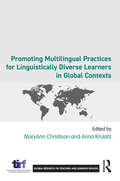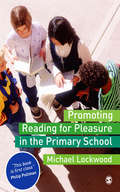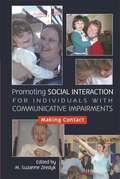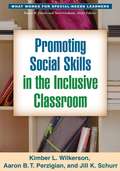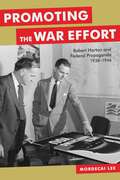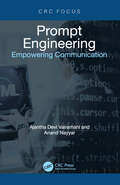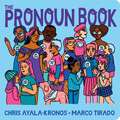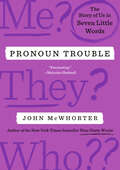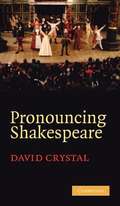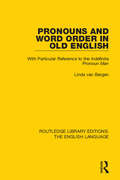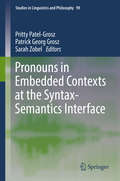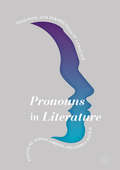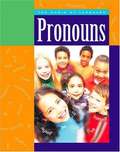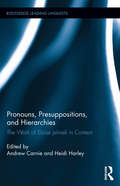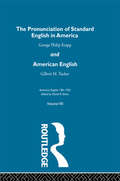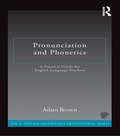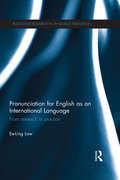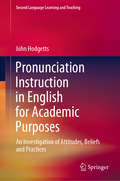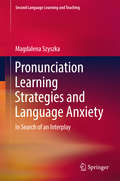- Table View
- List View
Promoting Multilingual Practices for Linguistically Diverse Learners in Global Contexts (Global Research on Teaching and Learning English)
by Anna KrulatzThe eleventh volume in the Routledge-TIRF series presents research on multilingualism in educational contexts across the globe. With chapters written by TIRF Doctoral Dissertation Grant awardees and internationally known scholars, the volume addresses the challenges and pedagogies associated with moving away from the monolingual paradigm to support the development of culturally and linguistically diverse learners. Offering original research, new models, and pedagogies on teaching from over 17 different countries, this volume familiarizes readers with the latest advances in theory and practice and is a key text for language education programs and pre-service teachers.
Promoting Reading for Pleasure in the Primary School
by Michael LockwoodWinner of the UKLA Author Award 2009:UKLA 'Lockwood has written a useful, supportive book which will help teachers and librarians...He describes the background and summarises the research and then proposes thoroughly practical programmes' - Carousel 'Michael Lockwood has produced an excellent, practical overview and analysis of what works in the primary school to promote reading for pleasure....Lockwood's work is grounded and valuable to those who need it most - teachers in the classroom working hard to engender a love of reading' - English Drama Media 'This book is first class. It puts the matter very clearly and succinctly, and presents a great deal of evidence to support the argument that pleasure is not a frivolous extra, but the very heart and essence of what reading is about. It also gives readers plenty of ideas for carrying the principle into the classroom, and for justifying it...This is an excellent piece of work, which I hope will find a place on every staffroom bookshelf.' - Philip Pullman English primary school children are less likely to read for pleasure than their counterparts in many other countries. This practical and focused book discusses the background to this situation and looks at how government initiatives have tried to address it. Drawing on the author's own research project in order to identify good practice in promoting reading for enjoyment, the book presents specific activities which teachers can use to develop their own whole school and classroom practice, enabling them to put the fun back into reading. Each chapter features case-study material and provides examples of planning from schools that have successfully created thriving reading cultures through schemes such as reading assemblies, book clubs, library loyalty cards, school book evenings and quizzes. There is also an extensive, annotated list of print and internet-based resources. Topics covered include: - Becoming a reading for pleasure school - Promoting a love of reading in the early years - Developing reading enjoyment in the later primary years - Getting boys reading Promoting Reading for Pleasure in the Primary School is written for all those involved in education who would like to see as many children as possible develop a love of reading. It will be particularly relevant for primary teachers, teaching assistants, trainee teachers, advisers and consultants, as well as teacher educators and researchers.
Promoting Social Interaction for Individuals with Communicative Impairments: Making Contact
by Martyn Jones Phoebe Caldwell Pete Coia Hilary Kennedy Suzanne ZeedykAll humans have an innate need and ability to communicate with others, and this book presents successful approaches to nurturing communicative abilities in people who have some type of communication impairment. The contributors look at a wide range of approaches, including intensive interaction, co-creative communication, sensory integration and music therapy, for a variety of impairments, including autism, profound learning disabilities, deafblindness, severe early neglect and dementia. This wide perspective provides insight into what it feels like to struggle with a communicative impairment, and how those who work with and care about such individuals can and should think more creatively about how to make contact with them. Covering both the theory and practical implementation of different interventions, this book will be invaluable for health and social work professionals, psychologists, psychotherapists, counsellors, speech and language therapists, as well as researchers, teachers and students in these fields.
Promoting Social Skills in the Inclusive Classroom
by Jill K. Schurr Aaron B. Perzigian Kimber L. WilkersonThis indispensable book presents evidence-based tools and strategies for improving the social skills of all members of the inclusive classroom (K-6), especially students experiencing difficulties in this area. The authors explain why social competence is critical to school success and describe interventions, curricula, and instructional approaches that have been shown to be effective at the schoolwide, classroom, and individual levels. Procedures for conducting assessments and developing individualized intervention plans are detailed. Reproducible forms can be downloaded and printed in a convenient 8 1/2" x 11" size.
Promoting the War Effort: Robert Horton and Federal Propaganda, 1938-1946 (Media and Public Affairs)
by Mordecai LeeThough historians have largely overlooked Robert Horton, his public relations campaigns remain fixed in popular memory of the home front during World War II. Utilizing all media -- including the nascent technology of television -- to rally civilian support, Horton's work ranged from educational documentary shorts like Pots to Planes, which depicted the transformation of aluminum household items into aircraft, to posters employing scare tactics, such as a German soldier with large eyes staring forward with the tagline "He's Watching You." Iconic and calculated, Horton's campaigns raise important questions about the role of public relations in government agencies. When are promotional campaigns acceptable? Does war necessitate persuasive communication? What separates information from propaganda? Promoting the War Effort traces the career of Horton -- the first book-length study to do so -- and delves into the controversies surrounding federal public relations.A former reporter, Horton headed the public relations department for the U.S. Maritime Commission from 1938 to 1940. Then -- until Pearl Harbor in December 1941 -- he directed the Division of Information (DOI) in the Executive Office of the President, where he played key roles in promoting the New Deal, President Franklin D. Roosevelt's unprecedented third-term reelection campaign, and the prewar arms-production effort. After Pearl Harbor, Horton's DOI encouraged support for the war, primarily focusing on raising civilian and workforce morale. But the DOI under Horton assumed a different wartime tone than its World War I predecessor, the Committee on Public Information. Rather than whipping up prowar hysteria, Horton focused on developing campaigns for more practical purposes, such as conservation and production. In mid-1942, Roosevelt merged the Division and several other agencies into the Office of War Information. Horton stayed in government, working as the PR director for several agencies. He retired in mid-1946, during the postwar demobilization.Promoting the War Effort recovers this influential figure in American politics and contributes to the ongoing public debate about government public relations during a time when questions about how facts are disseminated -- and spun -- are of greater relevance than ever before.
Prompt Engineering: Empowering Communication
by Ajantha Devi Vairamani Anand NayyarPrompt engineering engages as a transformative approach to enhancing interaction, creativity, and innovation. From business and healthcare to education, law, and beyond, prompt engineering is a versatile toolkit for navigating complex challenges and driving meaningful change.This book delves into the intricacies of prompt engineering, providing insights, techniques, and practical examples for leveraging prompts effectively. It explores the evolution of prompt engineering, from its early antecedents to its contemporary applications with advanced language models like ChatGPT. Readers will discover how prompts can enhance communication, foster creativity, facilitate problem-solving, and empower professionals across diverse domains.This book is your gateway to unlocking the full potential of prompt engineering. Join the journey of discovery and innovation as the book harnesses the power of prompts to shape a brighter future.
The Pronoun Book
by Chris Ayala-KronosThey, she, he...all together, us! Join along in this vibrant book's joyful celebration of people and their pronouns.
Pronoun Trouble: The Story of Us in Seven Little Words
by null John McWhorterWith his trademark humor and flair, bestselling linguist John McWhorter busts the myths and shares the history of the most controversial language topic of our times: pronounsThe nature of language is to shift and evolve—but every so often, a new usage creates a whole lot of consternation. These days, pronouns are throwing curveballs, and it matters, because pronoun habits die hard. If you need a refresher from eighth-grade English: Pronouns are short, used endlessly, and serve to point and direct, to orient us as to what is meant about who. Him, not her. Me, not you. Pronouns get a heavy workout, and as such, they become part of our hardwiring. To mess with our pronouns is to mess with us. But many of today&’s hot-button controversies are nonsense. The singular they has been with us since the 1400s and appears in Shakespeare&’s works. In fact, many of the supposedly iron-clad rules of grammar are up for debate (Billy and me went to the store is perfectly logical!), and with tasty trivia, unexpected twists, and the weird quirks of early and contemporary English, John McWhorter guides readers on a journey of how our whole collection of these little words emerged and has changed over time.
Pronouncing Shakespeare: The Globe Experiment
by David CrystalIn an unusual blend of autobiography, narrative, and academic content, reflecting the unique nature of the experience, David Crystal recounts the first attempt in over 50 years to mount a full-length Shakespeare play in original pronunciation.
Pronouns and Word Order in Old English: With Particular Reference to the Indefinite Pronoun Man (Routledge Library Editions: The English Language #2)
by Linda van BergenFirst published in 2003, this is a study of the syntactic behaviour of personal pronoun subjects and the indefinite pronoun man, in Old English. It focuses on differences in word order as compared to full noun phrases. In generative work on Old English, noun phrases have usually divided into two categories: 'nominal' and 'pronominal'. The latter category has typically been restricted to personal pronouns, but despite striking similarities to the behaviour of nominals there has been good reason to believe that man should be grouped with personal pronouns. This book explores investigations carried out in conjunction with the aid of the Toronto Corpus, which confirmed this hypothesis.
Pronouns in Embedded Contexts at the Syntax-Semantics Interface
by Pritty Patel-Grosz Patrick Georg Grosz Sarah ZobelThis volume presents studies on pronouns in embedded contexts, and offers fundamental insights into this central area of research. Much of the recent research on pronouns has shown that embedded environments, such as clausal complements of attitude predicates, provide a window into the nature of pronouns. Pronouns in such environments not only exhibit familiar distinctions such as that between bound and referential pronouns; if they refer to the attitude holder, they also participate in a broader range of phenomena, e. g. , distinguishing between a de se reading (involving a conscious self-directed belief) and a de re reading (involving an accidental belief about oneself). Topics covered include: the semantics of attitude reports that contain pronominal elements, the semantics of pronominal features and their connection to indexicality, new insights in the connection of pronominal typology and logophoricity or anti-logophoricity, and finally, the localization of embedded pronouns within a bigger picture involving the nature of perspective and the analysis of quasi-pronominal phenomena such as sequence of tense.
Pronouns in Literature
by Alison Gibbons Andrea MacraeThis edited collection brings together an international, interdisciplinary group of scholars who together offer cutting-edge insights into the complex roles, functions, and effects of pronouns in literary texts. The book engages with a range of text-types, including poetry, drama, and prose from different periods and regions, in English and in translation. Beginning with analyses of the first-person pronoun, it moves onto studies of the subject dynamics of first- and second-person, before considering plural modes of narration and how pronoun use can help to disperse narrative perspective. The volume then debates the functional constraints of pronouns in fictional contexts and finally reflects upon the theoretical advancements presented in the collection. This innovative volume will appeal to students and scholars of linguistics, stylistics and cognitive poetics, narratology, theoretical and applied linguistics, psychology and literary criticism.
Pronouns (The Magic of Language)
by Ann HeinrichsI love pronouns. She loves pronouns. He loves pronouns. Do you love pronouns, too? If you don't now, you'll learn to love pronouns as you read this book! Learn how to identify and use pronouns in writing, reading, and speaking. We all love pronouns!
Pronouns, Presuppositions, and Hierarchies: The Work of Eloise Jelinek in Context (Routledge Leading Linguists)
by Andrew Carnie Heidi HarleyEloise Jelinek was a leading authority on syntactic and semantic theory, information structure, and several Native American languages (including Lummi, Yaqui, and Navajo). She was one of the very first generative linguists who brought the theoretical implications of the properties of typologically unusual and understudied languages to the forefront of mainstream generative thinking. Jelinek originated the Pronominal Argument Hypothesis – the idea that many languages restrict realization of their arguments to pronouns. In other work, Jelinek investigated a broad range of morphological, syntactic and semantic phenomena in understudied and endangered languages. Besides the theoretical value of that work, it was instrumental in providing sophisticated semantic and syntactic documentation for such languages, where description is typically limited to the basic morphophonology and morphosyntax, as well as texts, that form the core of most descriptive work. Thirteen of her most important papers, together with a fourteenth essay previously unpublished, are here collected, each preceded by a short introduction that provides context for the work and evidence of its subsequent influence.
Pronunc Standard Eng America V: and American English
by Daniel R DavisFirst Published in 2003. Routledge is an imprint of Taylor & Francis, an informa company.
Pronunciation and Phonetics: A Practical Guide for English Language Teachers (ESL & Applied Linguistics Professional Series)
by Adam BrownThis engaging, succinct text is an introduction to both phonetics and phonology as applied to the teaching of pronunciation to English language learners. Section 1 selectively covers the main areas of phonetics and phonology, without going into any area in more depth than the average English language teacher requires or that the average English language teacher trainee can handle. Section 2 focuses on practical issues related to learners and how they learn languages, and what represents good practice in terms of classroom activities for pronunciation—including aspects such as targets, motivation and priorities. The chapters end with activities to help the reader understand concepts. Section 3 provides innovative sample activities which put into practice the theoretical points covered in the first two sections, answers to the various exercises, recommended further reading (both print and non-print), a glossary of technical phonetic terms, and a bibliography of works on pronunciation teaching. The text is accompanied by a Companion Website with audio recordings of model pronunciations and audio material relating to the activities.
Pronunciation for English as an International Language: From research to practice (Routledge Research in Language Education)
by Ee-Ling LowPronunciation plays a crucial role in learning English as an international language, yet often remains marginalised by educators due to a lack of required phonetic and phonological knowledge. Pronunciation for English as an International Language bridges the gap between phonetics, phonology and pronunciation and provides the reader with a research based guide on how best to teach the English language. The book follows an easy to follow format which ensures the reader will have a comprehensive grasp of each given topic by the end of the chapter. Key ideas explored include: • Articulation of English speech sounds and basic transcription • Connected speech processes • Current issues in English language pronunciation teaching • Multimedia in English language pronunciation practice • Using speech analysis to investigate pronunciation features Using the latest research, Pronunciation for English as an International Language will facilitate effective teaching and learning for any individual involved in teaching English as a second, foreign or international language.
Pronunciation in EFL Instruction
by Jolanta Szpyra-KozłowskaIn view of recent debates on the global spread of English and its international lingua franca role, what pronunciation models are appropriate for millions of EFL learners? Which aspects of English phonetics should be taught to foreign students and which can be neglected with little loss to successful communication? How can English pronunciation be taught in an interesting and effective way which is both learner- and teacher-friendly, in accordance with the latest scholarly and technological achievements? This research-based book addresses these and many other fundamental issues that are currently at the centre of pronunciation teaching. It offers a wealth of new theoretical ideas and practical solutions to various phonodidactic problems that arise in EFL contexts, approaching pronunciation instruction from global and local perspectives and supporting its theoretical claims with extensive empirical evidence. It will be of interest to EFL teachers and teacher trainers, pronunciation specialists and students of applied linguistics.
Pronunciation Instruction in English for Academic Purposes: An Investigation of Attitudes, Beliefs and Practices (Second Language Learning and Teaching)
by John HodgettsThis book examines the pronunciation goals of teachers, course leaders, and learners on a ten-week UK pre-sessional access course, particularly with regard to suprasegmental instruction and target of instruction on how these goals are reflected in pronunciation assessment, and how teacher goals are informed by their attitudes and beliefs. A mixed methods approach, including direct observation and semi-structured interviews, is employed to address the area of enquiry. Results show a lack of clarity of course goals. Although there is a firm emphasis on suprasegmental instruction, in semi-structured interviews, teachers report a lack of clear course goals and guidance. Assessment and practice do not always adhere to a goal of intelligibility, and support for teachers, in terms of the materials and how they might be exploited seems limited. The book concludes with tentative recommendations on how suprasegmental instruction might be facilitated on EAP and other courses
Pronunciation Learning Strategies and Language Anxiety
by Magdalena SzyszkaThis book presents theoretical considerations and the results of empirical research on pronunciation learning strategies (PLS) deployed by pre-service trainee teachers majoring in English as a foreign language who experienced different levels of language anxiety (LA). The theoretical part focuses on the concepts of pronunciation learning, pronunciation-learning strategies and language anxiety and includes an overview of recent empirical research dealing with various related issues. The empirical section of the book presents the findings of a research project that investigated the interplay between PLS and LA, in which both quantitative and qualitative data were collected. Based on the findings, the author proposes two profiles of anxious and non-anxious EFL trainee teachers who support their pronunciation learning with an array of pronunciation learning strategies and tactics.
The Pronunciation of New Testament Greek: Judeo-Palestinian Greek Phonology and Orthography from Alexander to Islam (Eerdmans Language Resources)
by Benjamin KantorWhat did the apostles&’ Greek sound like?How would New Testament Greek have been pronounced? Often students are taught Erasmian pronunciation, which does not even reproduce Erasmus&’s own pronunciation faithfully, let alone that of the New Testament authors. In his new book, Benjamin Kantor breaks a path toward an authentic pronunciation of Koine Greek at the time of the New Testament.The first comprehensive phonological and orthographic study of Judeo-Palestinian Koine Greek, The Pronunciation of New Testament Greek surveys thousands of inscriptions and papyri to determine its historical pronunciation. Benjamin Kantor covers his cutting-edge methodology, the chosen sources, and their context before explaining the pronunciation of each Greek phoneme individually. Written for interested students and specialists alike, this guide includes both explicatory footnotes for novices and technical analysis for veterans.
Proofreading and Editing in Student and Research Publication Contexts: International Perspectives (Routledge Research in Higher Education)
by Nigel HarwoodThis book explores proofreading and editing from a variety of research and practitioner-led perspectives to describe, debate, and interrogate roles and policies within the student and research publication context.Chapters feature a wide range of empirical research findings gathered from an internationally diverse set of experts in the field from Australia, Canada, Finland, Hong Kong, the UK, and the USA. The book progresses debates surrounding the legitimacy and necessity of copyeditors and proofreaders, drawing upon a range of theory and practice. Contributing to further research and dialogue in the area, the book addresses the ethicality and educative benefits of proofreading from various perspectives.Ultimately, the book offers vital discussions about the ethics and boundaries of proofreading and editing with experts sharing their experiences and recommendations for next steps. This book will be of relevance to postgraduate students, researchers and academics in the fields of literary studies, higher education, language arts, and applied linguistics. Teaching and learning professionals, policymakers, proofreaders, and editors can also benefit from the volume.
Proofs Of Genius: Collected Editions From The American Revolution To The Digital Age
by Amanda Gailey"Proofs of Genius: Collected Editions from the American Revolution to the Digital Age is the first extensive study of the collected edition as an editorial genre within American literary history. Unlike editions of an author's "selected works" or thematic anthologies, which clearly indicate the presence of non-authorial editorial intervention, collected editions have typically been arranged to imply an unmediated documentary completeness. By design, the collected edition obscures its own role in shaping the cultural reception of the author. In Proofs of Genius, Amanda Gailey argues that decisions to re-edit major authorial corpora are acts of canon-formation in miniature that indicate more foundational shifts in the way a culture views its literature and itself. By combining a theoretically-informed approach with a broad historical view of collected editions from the late eighteenth century to the present (including the rise of digital editions), Gailey fills a gap in the textual scholarship of the editing history of major figures like Emily Dickinson and Walt Whitman and of the American literary canon itself"--
Propaganda: The Basics (The Basics)
by Nathan CrickThis concise and accessible guide makes clear the ubiquity of propaganda so that readers can understand its function in all layers of society, for both good or for ill, and ultimately use it to make their own voice heard.Propaganda often appears as a paradoxical art: modern society is awash in propaganda and yet many deny consuming it. Using short, easy to understand examples drawn from politics, culture, and advertising from around the world, this book introduces readers to the basic theory, research, and techniques of propaganda from the American Revolution to the present day. It demystifies propaganda for the purpose of democratizing it, revealing it as a form of mass persuasion that is a necessary part of political culture and essential to promoting social movements, social reforms, political agendas, scientific ideas, and aesthetic tastes. The book emphasizes the creative aspect of propaganda while also stressing the need for critical media literacy and ethical judgment.Filling a major gap in the literature, this book is an essential read for students of persuasion, rhetoric, communication, journalism, advertising, and public relations. It is also ideal for anyone interested in the fundamental principles and tactical forms of propaganda and those approaching the subject for the first time.
Propaganda: Ideas, Discourses and its Legitimization (Chinese Perspectives on Journalism and Communication)
by Hailong LiuPropaganda is subjective information primarily used to influence an audience and further a political agenda. In China, it has a long history but has been most effective in modern society. What exactly is propaganda? Why does it exist and why does the public tolerate it? The book answers these questions by tracing back to the emergence and development of integrated propaganda and scientific propaganda. On this basis it focuses on the emergence of propaganda concept in China, the establishment of Kuomintang and the Communist Party of China’s propaganda concept, intellectuals and propaganda, the debate on the propaganda concept in China after 1949 as well as the emergence of Propaganda 3.0 that coordinates integrated propaganda and scientific propaganda. Setting propaganda in the framework of modernity, the book explains how various groups have legitimatized propaganda since the 20th century. From a reasonable and neutral standpoint, the author describes the confrontation among various propaganda concepts and discourses, displaying a panorama of the mutual conflicts between nations and individuals, control and freedom, ideas and bodies. Not only will scholars and students studying journalism and communication find this book interesting, but professionals working in journalism, advertising, public relations and publicity will also find it engaging and enlightening.
